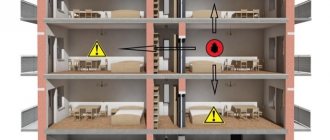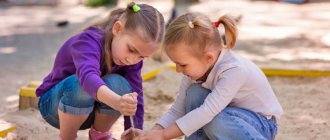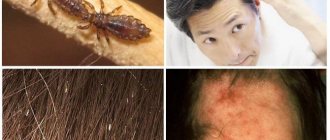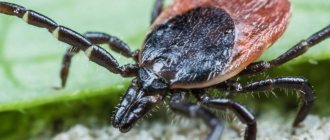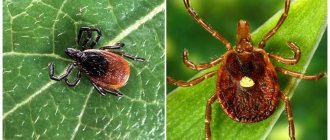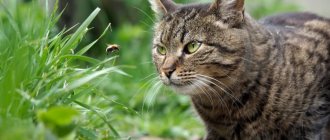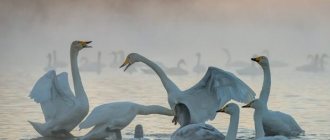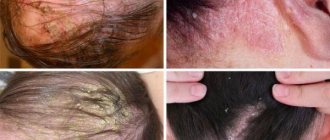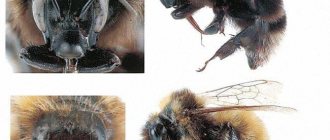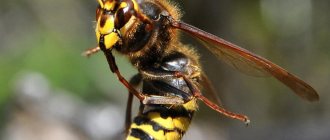What measures should parents and administration take when head lice appears at school is a question that will interest everyone who has encountered such a nuisance at least once in their life.
The problem of lice in children visiting public places: kindergartens, schools, summer camps is very acute, despite the fact that it is the 21st century and many parents think that lice are a relic of past years or a problem for people without a fixed place of residence. , i.e. homeless people In reality, any person, regardless of lifestyle and living conditions, has a real chance of becoming infected with lice.
Lice and nits
Most often, parents learn from the class teacher that there is lice in the class and some students are infected, or they accidentally discover insects on their child. In such a difficult situation, the question arises: what to do, namely, how to get rid of lice and what the actions of the administration of the educational institution will be, and also where to complain if no measures are taken.
What to do if there are lice at school: what to do
If you yourself discover uninvited tenants on your child’s head, do not panic. First of all, you need to understand that head lice is a problem that does not depend on hygiene and social status. Lice absolutely don’t care whether a child’s hair is clean or dirty, what brand of shampoo he washes his hair with and how often. If there are lice at school, then all children have the same risk of becoming infected. Therefore, do not be nervous - your mood may confuse or upset the child, but he is not to blame for anything.
The first thing to do is to notify the class teacher and the school nurse. If your child goes to clubs or sports clubs, you should notify their leaders. After this, it is necessary to carefully check the heads of all family members and begin treatment.
Lice are insects that require certain temperature conditions and nutrition to survive. Therefore, they cannot survive without a host. In one study, scientists checked the surfaces of desks, chairs and floors in a classroom with an outbreak of head lice. No live insects were found. This means that during treatment you do not have to do a complete sanitization of the apartment.
Modern anti-pediculosis agents help effectively combat both lice and nits, which makes treatment quick and effective.
Why does lice infection occur? General information:
- Pediculosis can be contracted in absolutely “unexpected” places, namely everywhere: in a shopping center, in a theater, in the subway, on a playground, in a taxi, on a school bus, at school and in kindergarten, in a children’s camp, in a gym. and at sports competitions.
- Lice do not choose sick, poor and disadvantaged people; the louse lives on any head, regardless of the property status and status of its owner.
- Pediculosis is not something shameful that should be hidden, lice is a common disease that needs to be treated, not in a single infected person, but in all people with whom the infected person has had contact.
- There is no effective lice prevention strategy.
- There are no statistics confirming that people who neglect personal hygiene get sick more often than clean people.
- Treating lice with folk remedies: combing out nits, vinegar, dust, essential oil, kerosene, lavender water, cranberries, homeopathy is useless, irresponsible and in some cases dangerous.
- Lice do not die and do not leave their homes, neither in the sea, nor in the sun, nor after taking vitamins. Pediculosis is not cured by “increasing immunity.”
- The only effective strategy in case of illness or receiving information about the illness of a person with whom you have had or continue to have contact (family member, colleague, child from the group in which your child is studying) is to treat all members with pharmaceuticals twice with a break of 7 days families, notification of everyone in contact with an infected person, daily examinations and monitoring for two months from the moment of illness.
- It is impossible to cure your child without notifying the administration of the school, kindergarten or other group in which the child is studying, and without achieving coordinated actions of all families of all children with whom the child comes into contact.
- Due to parents' ignorance, shame, and lack of a coordinated strategy among all members of the team regarding head lice, lice are never removed in the vast majority of children's institutions.
- In kindergartens and schools, it is necessary to act in a coordinated manner: simultaneously treat all children and teachers twice with a break of 7 days, conduct sanitary treatment with hot steam in the school/kindergarten premises, in cars and school buses, and examine all family members at home daily.
- There is no need to introduce a quarantine for head lice.
Important! Lice are not a shame, lice are a big problem if it is kept quiet and not solved! You can only get rid of head lice in a group of children together
Where to report if there are lice in the classroom?
As mentioned above, you just need to notify your class teacher and school nurse about the problem. They, in turn, must notify the parents of all children in the class and ask them to take action. If the problem is not resolved, you can file a complaint with the school administration.
Many parents do not fully understand how head lice is localized at school. They imagine it this way: the institution is closed for quarantine and a total sanitary treatment of the premises is carried out. Therefore, complaints should be addressed first of all to the SES.
Today, such a structural unit as the SES does not exist. Her duties are carried out by Rospotrebnadzor, which monitors the implementation of anti-pediculosis measures in schools. According to current sanitary standards, during an outbreak of lice, floors, furniture and walls cannot be treated. Only mats in school gyms are treated. Therefore, the main responsibilities for preventing the spread of infection fall on the shoulders of parents. Each of them is obliged not only to remove their child, but also to make sure that the treatment was effective and the possibility of recurrence of head lice is excluded.
“The SES and the director must treat the entire school from the attic to the basement with chemicals! Manually!"
SES no longer exists. There is a successor to this organization - Rospotrebnadzor, which ensures that schools carry out “anti-pediculosis measures.” But this does not mean that the building must be dismantled brick by brick. Here is what is said on this topic in the decree of the chief sanitary doctor of the Russian Federation dated 06/07/2017 (in Appendix No. 2): “In the outbreak of head lice, treatment of furniture, walls, floors, and clothing is not required. Mats in school gyms must be treated.”
And only if body lice, and not head lice, were found (they often live on homeless people, and are very rarely brought into schools), serious sanitation is required. The above resolution says: “When body lice are detected, anti-pediculosis measures are carried out in the outbreak, as well as in places where people and their clothes are examined, premises (floor, chairs, couches, door handles and other objects) with pediculicidal agents.
How do parents imagine this? All the classes are standing in a long line on the street, while one (maximum two) nurses at the school door is rummaging through the head of another student? This “entry control” will take several hours. But a nurse can stand at the door of the classroom (if several cases of head lice are registered there). She must check several times (at intervals) to see if new generations of insects have appeared in the class.
Is it possible to go to school with head lice?
No. If your child has been found to have lice, he does not have the right to attend school until they are completely eliminated, which is confirmed by a certificate from a dermatologist. This approach outrages many parents: not only did my child catch lice in class, he now also has to miss classes. But in practice, not everything is so scary. Modern pediculicides can get rid of the problem in just one treatment. As for nits, empty (or dead) lice eggs are not a barrier to school attendance. The main thing is that at the time of examination the child does not have live lice or nits.
Treatment of lice
Treatment of lice It is recommended to use modern lice preparations.
Sold in pharmacies in the form of shampoo, spray, solution, ointment. With the right approach, lice can be removed in one procedure, but to consolidate the result, repeated treatment is carried out after 14 days. How many days a child cannot attend school depends on the efforts of adults aimed at removing parasites. And also standards. Treatment for pediculosis is carried out twice every 14 days. Therefore, a child can appear at school no earlier than this period.
Preparations for lice – Pedilin, Hygia, Nyuda, Para Plus, Paranit, Nyx, Veda. Special products – Hellebore water, benzyl benzoate emulsion, Medifox. Before using any drug, a sensitivity test must be performed. Nits are removed by combing out. Buy a special comb with fine teeth if it does not come with a head lice remedy.
On a note!
Modern remedies act quickly and are safe for health. Easy to use, the procedure lasts no more than 30 minutes. It will take much longer to fight lice using folk remedies. To protect your child from unnecessary emotions, it is better to immediately use professional medications.
At home, everyone living under one roof should be treated and the apartment should be sanitized. The childhood disease is easily transmitted to adults.
Quarantine for head lice: when is it introduced, how long does it last?
If lice are found on two or three children in a class, no quarantine measures are required. In the event of a mass outbreak of the disease, the nurse is obliged to notify Rospotrebnadzor. Each case of parasitic diseases is registered in the register of infectious diseases at the place where they were detected.
Quarantine for head lice is introduced for 30 days. During this period, schoolchildren continue to attend classes. Quarantine measures consist of weekly checks of students for lice and live nits. A more strict quarantine, which includes preventing schoolchildren from attending classes, is possible if outbreaks of head lice are recorded in several classes of the school.
Symptoms of lice
Parents should clearly understand that head lice is a common disease. It does not carry any intimate factors. Infection of a child with head lice in a kindergarten group is quite common. This is due to the large concentration of people in a confined space. Main methods of infection:
- Contact: lice are transmitted through close interaction from child to child during games and activities.
- When exchanging personal items: children love to exchange clothing items, including hats; in addition, the use of shared hygiene products, such as combs and towels, can lead to the transfer of lice and nits.
- Shared bed: Contact with other people's bedding during quiet times can also lead to parasite infection.
Pediculosis in children is usually a widespread disease. If one child is infected, there is a high probability that almost the entire group will become infected.
https://www.youtube.com/watch?v=upload
Pediculosis is quite easy to identify. Symptoms are pronounced:
- severe itching of the skin in the hairline area;
- the appearance of characteristic spots from insect bites, often ulcers (children scratch the bite site);
- presence of adult parasites;
- on the hair, mainly at the roots at a distance of 1 cm from the skin, there are oval grains - nits (eggs);
- Scaly lesions may appear (behind the ears, on the back of the head).
If symptoms occur, it is necessary to pick up the child from kindergarten as soon as possible, buy a product and carry out treatment, as well as disinfect personal belongings.
Certificates for pediculosis: where to get?
After a case of lice in a child is recorded by the school nurse, he is suspended from classes and can return to school after complete recovery, confirmed by a doctor’s certificate. Please note that such certificates have a very short validity period - only 3 days. Therefore, if, after passing the test, the child for some reason is unable to come to school within the specified period, the certificate will have to be taken again
The document is issued by a pediatrician. He carefully examines the child's head for lice and live nits, and, if everything is in order, makes the appropriate mark on a special form. If lice are found during the examination, the doctor will give recommendations on the correct treatment.
More on the topic “Lice in a child”:
Philosophical about ancient insects...
They continue to bring a lice-infested child to the kindergarten... In the early 90s, she worked as a teacher in a kindergarten and was infected with lice twice from children.
Pediculosis…
Pediculosis…. Medicine/children. Adoption. Discussion of issues of adoption, forms of placing children in families, raising adopted children, interaction with guardianship, training at school for adoptive parents. Pediculosis: what parents and children need to know.
Inactive form of pediculosis. What's this? Who knows?
Pediculosis: what parents and children need to know. About lice again: don't go to school? sick of lice at school. This is the third time a child has brought lice from school, it’s good that I have a boy, well, yesterday they cut his hair and washed him again, the main thing is that he hasn’t been anywhere in particular, with his grandmothers, with...
Help!!! How to get rid of lice?
Tell me the child has lice, what to do. lice. My sister got lice out of her little daughter (2 years old). How to get lice out? Does your child have lice? And what to do with lice? how to fight?
relatives do not recognize the fact of head lice in the child
Raising a child from 10 to 13 years old: education, school problems, relationships with classmates, parents and teachers Pediculosis: what parents and children need to know. Lice in a child: first reaction. Not all parents are able to keep Mom...
sick of lice at school
Lice are a common sight in schools. And even in our private ones they happen. The child brings a letter that “one of the children in the class has lice, please take note of the attached information” and a photocopy of a brochure about Pediculosis: what parents and children need to know.
Question about pediculosis
Question about pediculosis. Need some advice. Pediatric medicine. Child health, illnesses and treatment, clinic, hospital, doctor, vaccinations. Pediculosis: what parents and children need to know. Lice in a child: first reaction. Conversation with a child.
About lice question...
I understand that you need to treat your head several times once a week and select nits, then they will come out anyway. And in the garden, I would suggest holding a meeting and all parents agreeing to head their children’s heads weekly. Pediculosis: what parents and children need to know.
Lice and kindergarten
Pediculosis: what parents and children need to know. If parents do not know about lice in a child care facility, then they do not check their own child’s head every day and carefully.
The child has lice...
The lice and nits were dead. Then I started disinfecting the house, boiled the bed towels with everything the child had come into contact with, and doused the comb with boiling water.
And what to do with lice? how to fight?
Pediculosis: what parents and children need to know. metal lice comb. I've been trying to remove lice from my child for about a month now. Pediculosis in children and adults: signs and treatment. Hair health. Lice and nits - how to fight.
About lice
About lice. Doctors, clinics, diseases. Child from 7 to 10. Raising a child from 7 to 10 years old: school, relationships with classmates, parents and teachers, health...
Pediculosis at school
Pediculosis: what parents and children need to know. sick of lice at school. School problems. Children's education. Head lice is a parasitic disease caused by small blood-sucking insects - lice...
lice in the garden again
There are lice in the garden again. Situation…. Child from 3 to 7. Education, nutrition, daily routine, visiting kindergarten and relationships with teachers, illness and physical development of the child...
About lice again: don't go to school?
One child has lice, the other is clean. Well, now, in fact, I’ve cleaned the first one. Can I come in? We also have lice at school, and my child caught it.
Tell me: My child has lice, what to do?
One child has lice, the other is clean. Lice…. My daughter was infected with lice in the HOSPITAL. metal lice comb. I've been trying to remove lice from my child for about a month now.
ethics question: lice!
ethics question: lice!. School problems. Children's education. My child has lice! Brought it from school (nowhere else). We are now actively undergoing treatment.
Sadov's troubles - I ASK FOR HELP!
BEFORE the parents arrive, the child must be isolated from other children (sitting in You know - you quickly take action, if you don’t know - don’t carefully examine the child’s head again And I didn’t write about the “shame” of lice! I just asked for advice from those who have encountered...
SanPiN for pediculosis
SanPiN is a document that describes sanitary and epidemiological rules and regulations for the prevention of parasitic diseases on the territory of the Russian Federation. It establishes the requirements for organizational and sanitary and anti-epidemic measures aimed at preventing the occurrence and spread of parasitic infections.
In accordance with the current SanPiN for pediculosis, measures to prevent the disease include:
- 1. Routine examinations of various population groups (schoolchildren should be checked every month)
- 2. Providing extended day groups of junior classes with replacement bed linen.
- 3. Suspension of students from attending school if head lice is detected, with the opportunity to return to classes after completing a set of treatment and preventive measures with a confirmatory certificate from a pediatrician.
- 4. Observation of persons in contact with a person with lice for 1 month and checks for lice once every 10 days.
These measures, combined with the organized actions of parents, are quite enough to prevent the spread of head lice.
Medical examination
Medical institutions should regularly check the population for lice infection in all places of constant contact of large groups of people: schools, kindergartens, correctional institutions, hospitals, etc.
Sanitary and epidemiological regulations indicate the frequency of such inspections and the rules for their conduct.
According to paragraph 3.12 of SanPiN 3.2.1333-03, the following population groups should undergo regular inspection for lice:
- Children living in orphanages and boarding schools are checked for head lice once a week;
- Hospital patients upon admission to inpatient treatment;
- Citizens working at enterprises and institutions are checked during routine medical examinations;
- Inspections of social security institutions take place twice a month;
- Schools and higher education institutions are inspected once a quarter. Schools are also required to conduct inspections after holidays and at the end of the school year.
In addition to examining the head, clothing is also checked for body lice.
Examinations may only be carried out by medical professionals.
Now you know how to check whether there are lice on your head, and are familiar with the methods of individual and mass testing of the population for lice.
Our website has many useful articles about pediculosis:
- Do lice grow on colored hair and what are the specifics of treatment and selection of anti-pediculosis agents?
- how to remove nits and lice from long hair without resorting to a “zero” haircut?
- what to do if lice appear on your head? First and subsequent actions!
- a cloudy pool of your eyes, or lice on your eyelashes;
- what to use to combat parasites on the head: what are lice and nits afraid of?
- treatment of pediculosis in pregnant women, as well as in nursing mothers: how to safely remove harmful parasites?
- pediculosis in adults: causes of infection and how to treat lice and nits?
- the best of the best: products for the prevention of head lice;
- consequences of lice or what are the dangers of lice?
How should a school inspection be conducted?
According to the results of epidemiological studies of group morbidity in school institutions, one of the main reasons for outbreaks of head lice are irregular and insufficiently high-quality examinations of children by school nurses. In addition, many schools often ignore the month against head lice, which traditionally should be held in September. Neglect of preventive measures on the part of school institutions leads to children bringing lice from home, after which the infection rapidly spreads among students throughout the school
Examination for lice should be carried out in a well-lit room with a magnifying glass and a fine-tooth comb. After each examination, the nurse should clean the comb with an alcohol solution. Inspections must be carried out after each holiday, as well as monthly on a sample basis: 4-5 classes from the school.
Action algorithm
When a person enters the emergency department, he is sent for examination. After which the feasibility of the treatment is determined. To do this, an examination of the scalp and an examination of the patient’s health condition are carried out. Measures to get rid of lice are carried out in a hospital. Premises should be closed, but with sufficient ventilation. Medical workers are obliged to respect the rights of patients, because manipulations are confidential. Medical staff take responsibility for patient safety, including infectious safety.
Preparation
When treating a patient against lice, the healthcare worker must follow the rules.
During preparation, follow the rules for inspection for lice. If the examination for lice is positive, the patient is informed of the diagnosis. Next steps for the junior medical officer:
- Obtain a doctor's order and the patient's consent for pest control work.
- Use additional protective equipment in the form of a scarf, a second robe, gloves, slippers and a mask.
- Cover the couch with an oilcloth sheet and place the infected person on it.
- Protect the patient's body from anti-lice treatments using an oilcloth drape.
How to treat the scalp for lice?
- Hair treatment using a solution. Strictly follow the instructions for use of the drug, since there are differences in whether the hair should be dry or wet, the period of stay of the drug on the patient’s head varies, ranging from 20 to 50 minutes. Apply the drug evenly, and under no circumstances allow it to come into contact with mucous membranes.
- Cover your hair with a polyethylene scarf and place a towel on top of your head. This stage lasts at least 20 minutes. The medicine is washed off with water, then the hair is washed with shampoo and the moisture is blotted with a towel.
- Warm up a 6% vinegar solution and treat the scalp. The point is repeated with a polyethylene scarf and a towel. Next, the hair is washed.
- Comb with a fine-toothed comb using a sheet of paper. It is worth combing the strands separately. Treatment of combs for head lice involves the use of anti-lice medications, alcohol, or sterilization.
- After this, the patient undergoes a second examination to detect lice. If the result is positive, the person will be subject to re-treatment. If the result is negative, the paper is burned. All items that were involved in the procedure, including the medical worker’s suit, are sent for disinfection.
Prevention of head lice at school: a reminder
Preventive measures to prevent the spread of head lice in school settings include:
- • Compliance with personal hygiene measures: the child must wash regularly, change underwear and bed linen. It is also necessary to systematically clean outer clothing.
- • Parents should regularly inspect their child's head for lice and nits.
In addition, parents should explain to children that it is important to avoid close contact with other children, especially if there is an outbreak of head lice at school.
Provoking factors and development of pathology
A louse is a small arthropod parasite that moves quickly and cannot fly. Its length reaches 5 mm, and its life cycle is about 40 days. Settling on human skin, lice feed on blood and lay eggs (nits) in the hair or clothing of their owner.
Various types of lice can live on animals - monkeys, horses, dogs, pigs. Three types of lice are dangerous to humans:
- pediculus humanus capitis (head);
- rhthirus pubis (clothes);
- humanus vestimenti (pubic).
Lice live only on the host, they quickly move from the body to clothes, underwear and hygiene items, but in need of food, they quickly find a new host and lay their eggs in the behind-the-ear or occipital area of the head (from five per day). The larvae also feed on blood. The appearance of lice causes severe itching and a local burning sensation. Constantly scratching bite sites can provoke secondary inflammatory processes.
The incubation period varies. In most cases, the parasite enters the hair or skin in its mature form, immediately starting to feed on blood, causing severe irritation. In rare cases, the onset of the disease may be hidden for the first 14 days.
Carriers of lice, or otherwise suffering from lice, are contagious. The main methods of infection are contact and household (through household items, clothing, bedding). In large crowded groups, lice spread quickly. This applies primarily to children's groups - summer camps, kindergartens, boarding schools, schools, sports sections.
The opinion that lice is a feature of asocial strata of society and underdeveloped societies has long been refuted. This disease affects adults and, more often, children, including those in quite prosperous families and social circles.
There are factors that contribute to the spread of head lice. Protection against lice will be more effective if you know these conditions and be extremely careful when they exist. The following risk factors can be identified:
- Favorable periods for outbreaks of pediculosis are wars, relocations, social conflicts, when the level of public sanitation and personal hygiene decreases.
- Lice easily spread in places where hygienic conditions are not sufficiently met - infrequent changes of linen, lack of treatment of upholstered furniture and outerwear lead to infection.
- Pediculosis is not a seasonal disease; you can get it at any time of the year.
- Although lice do not live long without a person, they can wait for a new owner in the folds of linen or clothing for up to several days; nit eggs are stored in things and can withstand heat treatment.
- The louse prefers clean skin and hair, which makes it easier to drink blood. Chemical hair styling and coloring products can repel it.
- The thinner and more delicate the skin, the more attractive it is to lice. Therefore, children are more likely to become infected with lice than adults.
- The louse is almost impossible to see - it is practically invisible in the hairline. The main symptom of the disease is nits - insect eggs firmly attached to the hair or clothing pile. They do not change position when the hair moves and are whitish or yellowish in color.
Traditional methods of treatment if you still become infected
There are many ways to combat head lice with products that can be found in any home. The most popular of them are:
- • Essential oils. The scent of many essential oils repels lice. To combat lice, you can use tea tree oil, eucalyptus, and lavender. However, remember that essential oils cannot be used in their pure form: they are added to shampoo.
- • Apple vinegar. This is a good remedy that helps get rid of not only lice, but also nits. Vinegar weakens the sticky substance that female lice use to attach nits to the hair shaft. For treatment, vinegar is diluted with water in a 1:1 ratio.
- • Garlic. It is believed that the specific smell of garlic repels lice. To prepare the mixture, crush 10 cloves of garlic and add 2-3 teaspoons of lemon juice to the paste. The mixture is applied to the hair for half an hour, after which it is washed off with water.
- • Mayonnaise. This method of treatment is based on the fact that the thick sauce deprives the insects of oxygen. Mayonnaise is applied to the hair for about an hour, after which it is necessary to thoroughly wash the hair with shampoo.
The undoubted advantage of treating lice with home remedies is that they are generally simple and cheap ways to combat parasites. However, they also have a significant disadvantage: in most cases, treatment is ineffective and comes down to mechanical removal of live insects and nits.
How to protect a child?
There are a number of preventive measures to protect children from infection:
- parents are obliged to monitor the appearance and neatness of the child;
- examine the head weekly, and during a mass disease - every day;
- It is better to collect or braid girls’ long hair;
- regularly wash and comb your hair with a personal brush;
- protect the child from communicating with children who have any symptoms of the disease;
- you can use essential oils of tea tree, mint, geranium, eucalyptus - they repel lice;
- from early childhood, explain that you need to use only your own things and personal hygiene items;
- regularly carry out preventive cleaning of the house with disinfectants or with the addition of vinegar.
Attentiveness, vigilance of parents and observance of basic rules of personal hygiene are the most effective in preventing the disease.
"Paranite": an effective way to get rid of lice
"Paranit" is a line of pediculicides of the latest generation. They contain dimethicone and mineral oil. These components are classified as low-hazard substances and are currently actively used in the production of cosmetics and hygiene products. The action of Paranit products is based on the fact that the active ones clog the respiratory openings of lice and nits, effectively destroying them after the first treatment.
The main disadvantage of most pediculicidal products is that lice become resistant to the toxic substances in their composition. “Paranitis” affects insects physically, so the effectiveness of treatment does not decrease even with repeated use of the products. Another advantage of Paranit pediculide products is that they can be safely used to treat children from 1 year of age and pregnant women (Paranit Sensitive). For parents of schoolchildren, Paranit products can be an excellent solution to the age-old problem of head lice outbreaks.
Means for prevention
Means for the prevention of pediculosis are special combs, sprays, ointments, and shampoos. Using an anti-lice comb is a non-chemical way to prevent lice. It involves mechanically combing out possible parasitic insects and their larvae from the hair.
When using medications, you should strictly follow the instructions, observe dosages and precautions.
Sprays:
- Paranit repellent. It is based on anise oil, which repels lice. Simply spray on hair. Provides protection for 24 hours. The main advantage of the product is the absence of any toxins.
- A-par. Disinfectant for treating clothing, bedding and any personal items. Destroys lice and nits.
- IceGuard. The drug is designed specifically for the prevention of parasites. Its smell repels insects. They can be used to process clothes and hats;
- Rosh Tov. The composition includes essential oils and plant extracts with an antiseptic effect.
Shampoos and creams:
Knicks. Permethrin-based cream is approved for children older than six months. A single use provides protection against infection for 2-6 weeks; during outbreaks, it can be applied to the hair once a week for 8 weeks. NOC. An effective cream-shampoo based on permethrin, approved for children over 2 years of age. Biosim. Shampoo based on permethrin, approved for children over 5 years old. Treatment for preventive purposes - no more than 2 times a month. Veda. For prevention, apply the product to damp hair and leave there until dry.
Use with caution; allergic reactions may occur. Parasidosis
Allowed for children from three months of age. This shampoo is based on a mixture of cocamidopropyl betaine and coconut acid, which is excellent against parasites. Pedilin. The shampoo contains components that are low-hazard to humans and effectively kill insects. An allergic reaction may occur with prolonged contact with skin. Paranit. One of the safest shampoos: does not contain insecticides, works due to mineral oil (clearol). The oil coats the bodies of lice and causes them to die from suffocation.
Signs of infection
From the moment a person becomes infected with lice until signs of infection appear, it can take from several days to 1-2 weeks. This is one of the reasons that parasites may appear in several children in a class before lice are identified. The speed at which symptoms manifest largely depends on the individual characteristics of the body.
Main symptoms of infection:
- constant, increasing itching of the scalp;
- change in scalp color, appearance of rashes, spots, flaky areas;
- bite marks, scratches;
- nits in the hair (most often they can be seen at the roots of the hair).
In case of prolonged infection, the scratches become inflamed and pustules appear. This indicates the addition of a secondary infection.
Duration of quarantine
If a child is found to have lice at home, parents should immediately notify the preschool institution about the incident and stay home. If lice were discovered by kindergarten staff, then the teacher is obliged to notify parents about this and completely isolate the child from other students in the group, while trying not to scare him or ruin his mood.
https://www.youtube.com/watch?v=ytcreatorsen-GB
After this, the health worker conducts an unscheduled examination of all students in the group and disinfects the premises. From this moment on, quarantine is declared. There is a regulated procedure in this case:
- The teacher is obliged to inform parents about the fact of detection of lice, maintaining confidentiality (the name of the infected child is not made public).
- The management of the preschool educational institution notifies the Central State Social Security Service at the place of registration of the child. If there are several cases in the group, then the information is sent to the assigned clinic with a statement about the outbreak of lice.
- Parents are briefed.
- The institution is quarantined for a period of 30 days.
During quarantine, disinfection measures are carried out in preschool educational institutions, including daily inspection of pupils and staff for problems. A sick child can visit the institution only upon presentation of a certificate of admission from the clinic or SES.
Actions after discovering head lice in a child
If a parent discovers that his child has contracted lice, then there is no need to panic. Although this is a rather unpleasant fact.
Modern preparations quickly and painlessly remove parasites from hair. You don't even have to visit a specialist.
Where should you contact immediately?
The first thing a parent should do is treat their child. You can contact your local doctor for clarification.
Visiting your primary care physician
He will prescribe medications that will eliminate lice. But, in most cases, parents act independently. Now there are many remedies for head lice.
The school, for its part, conducts explanatory conversations about hygiene rules. Until the child is completely healthy, he will not be allowed to attend classes.
Self-treatment
Medicines to get rid of lice:
- Benzyl benzoate. Available in the form of a cream. It has a detrimental effect on parasites within a few hours.
- Parasidosis is a shampoo that comes with a comb. It has a toxic effect on individuals, dissolving the composition with which they are attached to the hair. This makes combing them out much easier.
- Permethrin. It can be in the form of both cream and shampoo. This is a kind of insecticide for hair.
- Para Plus. Available in aerosol form. They treat hair, as well as everything that the child has come into contact with.
Previously, lice were fought using radical methods, that is, by shaving off the hair. But, if the child is small, then this can be done. At school age, this is almost impossible.
It should be recognized that this procedure is the most effective. After it, you need to disinfect things in the apartment, as well as clothes.
The method of getting rid of lice is still practiced in children's homes because it is cheap and effective.
Another method is combing. It is difficult, long, and the process is made difficult by the child’s long hair.
The process of combing out lice with a special comb
Before this procedure, you still need to use a special shampoo that will make combing easier.
Lice are removed with a comb; it must be guided from root to tip. This should be done over white paper. Then they burn it. The process is repeated for 14 days, every three days.
This is done in order not to miss new hatched lice. For maximum effect, a lot of effort should be made.
Among the new methods, combs with a weak electrical impulse can be noted. They run on batteries.
Electric comb for the treatment of head lice
A low current is believed to kill lice. Whether this is effective or not has not yet been decided. People prefer shampoos and creams that 100% get rid of the scourge.
There are traditional ways to combat lice. It is worth noting that each of them is dangerous in its own way.
Products used:
- kerosene;
- dust soap;
- vinegar;
- dichlorvos;
- automotive fluid.
Given the developments of the modern pharmaceutical industry, these methods should be left in the past.
Actions to take when identifying parasites
The algorithm for examining a patient for pediculosis allows you to quickly and accurately make the necessary diagnosis and prevent the spread of the parasitic infection. Manipulation can be carried out in preschool institutions, camps, kindergartens, and schools.
When an infection is detected in a child, the school does not draw up a report, but a special log is kept. Children are excused from classes and treated at home, but if necessary, they can go to the clinic. They are given a certificate of forced absence from classes.
If lice are detected in a hospital, the infected person is isolated, his clothes and bedding, as well as items worn by the staff at the time of the examination, are subjected to heat treatment and disinfection. The patient himself is treated according to the existing method:
- The couch is covered with a sheet or film.
- A cape is placed over the patient's shoulders, and the face is protected with a roller around the head.
- The hair is combed and treated strand by strand with the selected anti-parasite product.
- Cover your head with a plastic cap and wait for the required time.
- Wash with warm water and shampoo, rinse with a solution of table vinegar.
- Put on a plastic cap again and hold for another 20 minutes.
- Rinse out the vinegar and wrap your hair in a towel.
- Nits and lice are combed out with a fine comb.
- All used instruments and materials are disinfected.
- Repeated examination of patients with head lice after treatment helps to exclude recurrence of infection.
Processing algorithm
The best prevention of infection and its spread is a routine inspection. It will allow you to detect lice at an early stage of infection and carry out therapeutic measures, which will stop the spread of the disease.
Checking for lice and nits is carried out if:
- Lice or nits were found on the hairline;
- The patient complains of itching, which gets worse at night;
- Bite marks are visible on the back of the head, behind the ears;
- Purulent inflammations are visible on the head.
Examination of the patient for pediculosis is carried out using a comb with long and frequent teeth.
Testing for the disease can be carried out by specialist doctors: pediatrician, therapist, infectious disease specialist, dermatologist, as well as a nurse or paramedic.
According to sanitary standards and rules, the following are subject to mandatory inspections and testing for disease:
- Children who are orphans or left without parental care and living in orphanages, boarding schools, orphanages;
- Children who enter kindergarten for the first time, or return there after a long (more than 7 days) absence;
- Children going to summer health camps, sanatoriums, boarding houses;
- Persons in places of deprivation of liberty, temporary detention centers;
- Citizens admitted for inpatient treatment.
Polyclinic checks are carried out at different intervals for certain age categories:
- Children under 6 years old – monthly;
- School-age children - after the holidays;
- Adults: in case of independent contact with specialists, if one of the family members has a disease, when going on vacation or recovery.
If head lice is detected in a class, group, or work team, an unscheduled inspection is carried out.
Examination of a patient for pediculosis in medical institutions (in particular, in a clinic) is carried out according to the “Protocol for the management of patients.”
Algorithm for detecting pediculosis (examination is carried out by a doctor or nurse using gloves):
- The patient's hair is unbraided and combed.
- Using a comb and a magnifying glass, the scalp is examined. In this case, the occipital and temporal parts are checked first.
- Underwear is checked.
- In patients over 10 years of age, the armpits and pubic area are checked.
At the end of the inspection, you must throw away the gloves and disinfect the comb in a special solution.
Disinsection measures when pediculosis is detected are carried out by the medical personnel of the enterprise or institution. If the disease occurs at home, the treatment is carried out by the public, after instructions. Random checks are carried out by employees of the sanitary and epidemiological service.
Treatment of a patient with pediculosis is carried out in a clinic. You must first obtain his consent. The room in which the procedure is carried out must be well ventilated. However, it cannot be performed on pregnant women, women in labor and nursing mothers, as well as children under 5 years of age.
Treatment of the scalp for pediculosis is performed as follows:
- The hair is moistened with a small amount of water heated to a temperature of 38°C.
- The hair is treated with an anti-pediculosis drug.
- The hair is covered with a plastic scarf, and a fabric scarf is put on top of it. The procedure lasts 20 minutes.
- Then wash with warm water and rinse with vinegar (6% or 9%).
- Combing is done with a fine-toothed comb.
- Rinse again and dry with a towel.
- Washed hair is examined for the presence of nits. If their number is small, then they are removed mechanically. If there are a lot of nits, the head is treated with a solution of 9% vinegar, and the head is again covered with a scarf for 20 minutes. Repeated disinfestation is carried out. There is no need to dry your hair with a hairdryer, since heat reduces the therapeutic effect of the drugs.
- At the end of the procedure, the patient’s linen and clothes are sent to the disinsection chamber.
Do not use the comb until disinfestation. Clothing and household items used by the patient must also be treated with anti-pediculosis agents.
The comb used for disinfestation is doused with boiling water or 70% alcohol. If an infection occurs with mixed, body or pubic lice, then boil the clothes in a soda solution for 15 minutes. After processing, it needs to be ironed.
Reprocessing
It is known that there is no drug that can destroy nits. Therefore, even after carefully performing their mechanical removal, it cannot be guaranteed that no nits remain in the hair. To avoid relapse, 2 weeks after the initial treatment, repeated treatment for pediculosis is carried out. The methodology is no different from the first stage.
How to protect yourself from head lice: general measures
The main preventive measure for the occurrence of head lice is educational work among preschool children and their parents, schoolchildren, and students. In addition, there are general recommendations:
- Regular shower.
- Daily change of underwear and change of bedding every 7-10 days.
- Regular visits to the hairdresser.
- Use only personal combs and hairpins.
- Regular cleaning of the house.
Diagnostics
To detect parasites, you need to carefully examine the scalp:
- If both live and dead lice are found, then lice have lasted for more than a month.
- Scales and crusts can be found on the roots of the patient's hair.
- Nits, unlike dandruff, are not shaken off or scattered.
If you suspect a head lice infestation, you should consult a dermatologist, who will use a Wood's lamp to make an accurate diagnosis. In the light of this device, lice are highlighted in blue, live nits are highlighted in white, and empty nits are highlighted in gray. If the diagnosis is confirmed, treatment begins immediately, patients are registered for a month with a mandatory examination every 10 days.
Wood's lamp is a device widely used in dermatology.
Inspection procedure
School lice inspections are performed by a nurse using a fine comb and a magnifying glass. The examination is carried out in a room with good lighting. Particular attention is paid to the hair on the back of the head and the area behind the ears. The results are recorded in a special journal. After each inspection, the comb must be disinfected by wiping with alcohol or pouring boiling water over it.
Inspection is a mandatory procedure carried out to prevent the spread of parasites among students and school staff. If a child is diagnosed with lice, the nurse notifies the class teacher and parents. The child's treatment is carried out by the parents. You can go to school only after the doctor, after an examination, confirms the absence of parasites and gives a certificate of complete recovery.
Why is lice dangerous?
One of the most dangerous consequences of lice is considered to be typhus, which can be contracted when bitten by a louse. During the Second World War, this infection affected more people than the night bombing of populated areas. The rapid spread of lice contributes to mass infection.
Children are the most cruel people on the planet. If a child with lice appears in a school group, there is a high probability that his peers will not allow him to forget about it. Psychological trauma is guaranteed. To prevent such a situation, it is necessary to explain to all children that no one is immune from this disease.
Do not forget about infectious lesions of the scalp. The wounds left after a louse bite may be susceptible to infection by the normal microflora of the skin (staphylococci and streptococci, which are not dangerous to a healthy body).
Preventive measures
Parents should know how to protect themselves from lice at school and what preventative measures they can use:
- during a period of mass disease, the child’s head should be examined daily;
- girls with long hair should wear it in a braid or a safer bun;
- comb your hair daily with your brush and wash your hair regularly;
- do not allow your child to play with children who have some symptoms of lice infection;
- You can protect yourself and your child from lice with the help of essential oils that repel insects: ylang-ylang, tea tree and other preventive agents.
Question about lice.
Good evening! Girls, tell me if anyone knows. In our garden, or rather in our group, lice have been wandering around for a month and a half now, and they just don’t want to stop. We were lucky for 1.5 months, once a lice was removed from a child in the group, but apparently she just jumped, she was lucky. but the drug was purchased on the same day, regularly, every other day, the teacher reports that some child in the group was found again.
The last time the girl was treated was on Monday... This evening I started scratching my head, found nits, immediately treated her and my sister, spent the allotted time, washed it, combed it, nothing fell out, dried my head, started looking again, and removed the lice, alive. and about three living nits, i.e. the remedy did not help.
I know that now in schools and kindergartens there is such a problem, surely someone has encountered such a problem, how do you cope with such a problem in your gardens and for how long, what procedures are carried out?
I’m already stupidly afraid to take my children to kindergarten... I’m lying there scratching myself... either it’s nerves, or I’ve caught it too.
What provokes / Causes of Pediculosis (lice):
Head lice (Pediculus humanus capitis) are transparent or grayish-yellow insects up to 4 mm long, parasitic mainly in the temples and back of the head, from where they can spread to other parts of the head. Over the course of 20-30 days, the louse lays up to 10 eggs (nits) per day. After 8-10 days, larvae form from the nit, which then turn into an adult louse, which after 10-15 days begins to lay eggs on its own. The lifespan of a louse is up to 38 days. Lice don't jump or fly, they crawl. Consequently, infection occurs through direct contact with hair, especially long hair, as well as through a towel, comb, and other things. A louse can crawl from one head to another in a train car, in a store, on the beach, in a swimming pool. When bitten, lice produce saliva, which causes quite severe itching. This leads to the appearance of scratching, disruption of the integrity of the skin, and the development of bloody crusts. Head lice are transmitted from person to person through direct contact (or through clothing, linen, household items, combs, etc.). Body louse (body louse) (lat. Pediculus humanus corporis De G. var. vestimenti, sometimes simply Pediculus corporis) is an insect, a human parasite, which is strictly monoxenous. Body lice have been known since ancient times. It is believed that in 1909, Charles Nicole, in experiments on the infestation of body lice on monkeys with typhus, first established that lice are carriers of typhus. However, in the domestic literature there are descriptions that this fact was established almost two decades (in 1892) before Nicolas’s experiments, by Kyiv University professor G. N. Minkh. Body louse usually parasitizes human clothing. At the same time, she lives and lays eggs (nits) in the folds of clothing and on its pile, and feeds temporarily from clothing to the skin. Lice are well adapted to feeding on hosts. It is believed that the body louse, in contrast to the head louse, is an evolutionarily younger species of parasite, since clothing as a substrate for arthropods to live in appeared much later than hair on the skin of mammals. The oral apparatus of a parasitic insect consists of piercing needles enclosed in a soft tube (proboscis) that turns out of the oral cavity, the edges of which are pressed tightly against the skin being pierced. Blood sucking is carried out due to muscle contractions of the pharyngeal pump and pharynx. Lice saliva contains an enzyme that prevents blood clotting. From the short esophagus, blood flows into the highly distended stomach. Typically, an adult drinks 1 to 3 µl (0.001-0.003 ml) of blood. The average weight of an insect is 1 mg. Females are larger and heavier and drink more blood than males. Through the translucent chitin, the process of lice feeding on blood is clearly visible: their abdomen swells, the intestines rhythmically contract, taking in more and more portions of blood, and their body becomes dark red. In 2010, the body louse genome was deciphered. Its volume turned out to be the smallest among all known insects - only 108 million nucleotide pairs. The pubic louse or louse (lat. Pthirus pubis) is an ectoparasitic insect from the suborder of lice (lat. Anoplura), living on the human body mainly in the pubic area, on the genitals, around the anus, less often in other hairy areas: in the armpits, on the chest and abdomen, in the area of eyebrows, eyelashes, mustache, and beard. It feeds exclusively on the blood of its owner. Without food it dies within 24 hours. However, outside the human body it can go into suspended animation and remain there for up to several months. The disease caused by this insect is called pediculosis pubis or phthiriasis. The size of a pubic lice reaches approximately 1-3 mm. Females are 1.5 times larger than males. The pubic louse lays eggs at the base of the hair, and itself is attached with its proboscis to the mouths of the hair follicles, usually on the skin of the pubis and scrotum. Infection occurs mainly through sexual contact. Infection through bedding is possible. It is impossible to become infected with lice from animals, since these parasites are species-specific and can only live on animals.
Recommendations for quickly killing lice
The choice of drug is always up to the parent. It is much easier to get rid of insects in the head if the child has short hair. To achieve high efficiency and quickly get rid of lice, you should adhere to the following rules:
- Strictly follow the instructions for the drug - age restrictions, technique of use.
- To remove lice from a child in 1 day, you need to treat the head with an anti-pediculosis agent, further soften the nit shell with a vinegar solution and thoroughly comb out each strand.
- Even if the packaging says that the drug destroys lice and nits in one application, you should not hope for it. The optimal treatment regimen is repeated treatment with combing out after 7-10 days. 100% destruction is guaranteed only by 3-fold processing in 7-10 days.
- Preparations with insecticides (permethrin, malathion, phenothrin) are used no more than 2 times a month. If there is no result, the remedy is changed.
- All insecticides are toxic to one degree or another! The concentration should not be exceeded when diluting medicinal emulsions.
- Anti-lice medications can provoke an allergic reaction. Before using them, it is advisable to conduct a skin test: apply a small amount of the drug to the elbow and see the reaction after a day.
Additional recommendations will help quickly destroy lice and prevent their re-production:
- Although they die at high temperatures, it is not recommended to use tongs or straighteners on children. This method not only damages the baby’s hair, but also does not exclude the possibility of getting a burn. In addition, nits are attached very close to the skin and can avoid harmful heat.
- If lice are found, be sure to treat them at home using insecticides (Avicin). Clothes and bed linen are washed/boiled (min. 55-60ºC). Sofas, pillows, blankets and mattresses are steamed on both sides. Clothes (jackets, hats) are also steamed, especially carefully at the seams. Toys that cannot be washed are taken out to the balcony and not used for at least 2 weeks. Direct sunlight and frost destroy parasites.
- Bed linen should be changed during treatment.
- All family members and those in contact with the sick child must be checked. Treatment is carried out simultaneously for all sick people.
- Kerosene should not be used for childhood lice. This is a fairly toxic substance that is absorbed into the blood and causes poisoning or long-term negative effects on the child’s psyche.
- Another folk remedy, hellebore water, has an effect if the patient’s hair is thin and short. Hellebore water is quite dangerous and provokes irritation of delicate children's skin; it cannot be used if there are wounds and scratches on the child's head.
- Anti-flea shampoos and drops for animals are strictly prohibited from being used on children. Having gotten rid of lice, you can be “rewarded” with toxic damage to the brain and other organs.
- Washing your hair with tar soap and adding eucalyptus and lavender oils to shampoos will not cure head lice in a child, but will somewhat reduce the risk of infection, since insects do not like such odors.
